Abstract
In article which is based on the compressed scientific and bibliographic analysis of a problem and data of testing poll of 200 children-bilinguals German-Russian-speaking and Russian-German-speaking, living in Russia and Germany, the attempt to reveal conditions and parameters of language preferences, the choice of the main language is given. The conducted research began with the analysis of the existing ways of the linguocultural development of bilinguals existing at the moment: a raster analysis of a profile, tests, sheets of observation and questionnaires for parents and teachers. In our research sample there were about 200 children whom (the informed concents of the parents were obtained) with complex work on identification of level of their communicative competence has been carried out (I-, socio-, cross-cultural, media and lingvo-making), with a dominant of their ethnocultural and language preferences. The balance level two-/multilingualism defines "quality" of the self-presentation and depth of self-identification of bi- and polilinguals in each language and in accordance with each etnolingvoculture they represent. At the same time, language is only a peculiar "thermometer" indicating the formation level of the communicative competence of the carrier of a communication situation. Taking into account that communicative competence includes 5 key components (content
Keywords: Bi-/polylingualismchildrenRussian Germansethnocultural codeslanguage preferencesetnolingvoculture
Introduction
The relevance of the topic is connected with the phenomenon of the XXI century – multilingualism (based on bilingualism), which in the context of globalization is inseparable from the desire of each ethnic group for self-identification and self-representation. Thus, different generations of Russian Germans in Russia, CIS countries and Germany are striving today to revive and maintain their ethnolinguistic identity and study their historical roots. Russian children, who find themselves in Europe, are also looking at their historical roots through connecting to the Russian language.
Problem Statement
Until now, researchers, for example, the authors of 40 English-language sources (2010-2017 scientific articles) drew attention to the following aspects that contribute to or impede the development of balanced bi-and poly-linguism and thereby determine the freedom of choice of the language of communication, the language preferences of natural bi- and polylinguas: this is the age of bilingual at the time of data generation; mixed or monocultural family, language of communication in the family, visiting the child’s studies in family language; the language of the country of residence (OED); The child has an adult or children's circle of communication in this language; The situation of communication (comfort, typicality, etc.)
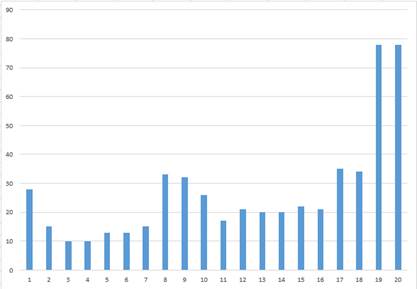
-
1. age of fixing data;
-
2. gender/ sex;
-
3. country of origin (age of the child at the time of the outcome) ;
-
4. country of the outcome (the situation of the child in the country of origin);
-
5. country of residence (length of stay);
-
6. country of residence (child's situation, for example);
-
7. mixed or mono-ethno-linguistic culture of the family;
-
8. language (s) of communication in the family;
-
11. presence of family (and child) contacts in the country; -
12. the social status of the family in the country of origin; -
13. the status of the family language in the country of residence; -
17. child’s availability a child and adult socium; -
18. psychophysiological state of the child; -
19. to be understood or misunderstood; -
20. the situation of communication (comfort, typicality).
Illustrations on the basis of 70 Russian-language narrow-thematic (related to the language preferences of natural bi- / polylinguals of school age) sources (scientific articles 2010-2017). Digital measures of the Y axis - the frequency of mentioning of the factors listed on the X axis in the following 60 articles. At the same time, the authors of the articles are Russian-speaking scientists living both in Russia and abroad. It is difficult to limit the sample to Russian-speaking foreign or Russian authors only, since many authors work simultaneously in the Russian Federation and abroad (110 papers in total). As we can see, from the criteria for the formation and development of natural bi-and poly-linguism, non-Russian scientists pay attention to purely linguistic factors, whereas their Russian-speaking counterparts, regardless of their country of permanent residence, take into account also the socio-ethnocultural and psychological-pedagogical components in various degrees. Look about it in works: Koudrjavtseva, Volkova (2014), Madden (2011), Rafieyan, Bin Abdul Majid, and Eng, (2013), Salimova (2012, 2014). The common is underlined everywhere: the languages of communication in the family; the intensity of communication in each of the child's languages in the family; the desire to be understood; situation of communication.
Research Questions
The parameters of individual development, communication situations, family biographies, etc., which are fundamental when choosing the language of communication and the language as the main language (and here we mean "verbal" as well as non-verbal, behavioral characteristics) for bilingual children living in a foreign environment; also the processes of interaction of languages and cultures in the environment of the child and their impact on the ethno-linguistic and cultural self-determination of the child.
Purpose of the Study
On the basis of a new concept to the problem of changeover by natural bi-and polylinguals of ethnolinguo-cultural (and not only linguistic) codes - a complex: socio-linguistic-ethno-psycho-cultural analysis of the personality of Russian-German and German-Russian bilingual (age at the time of the interview in the 2000s from 3 to 18 years, the country of permanent residence is Russia, Kazakhstan or Germany). Today, observation and questionnaires are used most intensely by parents and educators, as there is often no possibility to conduct formalized testing. Observations of the individual process of physical, mental and speech development of the child are documented (for example, on the pages of the calendar-portfolio of bilingual, in the section "Portfolio of Communications"). The brief overview allows us to identify the main problems that have not been solved in the existing ways of diagnosing and monitoring the linguistic and cultural development of bilinguals of 3-14 years: 1) the declaration of age-specific features of children without its consistent implementation; 2) absence of linguocultural anamnesis of another language; 3) ignoring the principle of compensatory action, which occurs in natural bi- / polylinguas; 4) failure to take into account the ethno-component; 5) testing of the formal language system of the language in isolation from the situations of using it; 6) neglect of the levels of the children's European language portfolio; 7) binding of the age of the tested to the level of language (under 12 year – уровни А, after 12 years – В etc.).
Research Methods
The theoretical basis was researchers of the domestic and foreign linguists, teacher-methodologists, psychologists (Wilhelm von Humboldt, Lev Vygotsky, Maslou, Torrance) etc., as well as the results of the research and educational activity and information of the target audience working in the international net laboratory Elabuga Institute of KFU «Innovative technologies in the sphere of multi-cultural education». Technologies and stages. At the result of researches of prototypes we worked out a system «Road Map Bilingual» (RoMBi©), or «bilingua roadmap» (BRM). This diagnostics and development system consists of 3 parts: 1) inquirer for parents and teachers combined automatically to one Internet- BRM/RoMBi©, 2) tests diagnosticating the presence of natural 2 languages and the level of its equilibration, including sheets of analysis of bilingua's difficulties with some ethnolinguistic combinations (Russian-German, Russian- Kazakh, etc.), 3) interactive «Calendar - portfolio of a bilingual of preschool age» (the work on the similar instruments for elementary school and secondary school is in process).
Let’s briefly stop on the first two components of this system. The BRM/ RoMBi© takes into account the specifics of the age and mental development of the natural bilingual, as well as the role of the ethnocultural and biographical (family’s and child’s biography) component. Questionnaires combine information Observation sheets of the child and information about activity-diagnosis of the family and educator of the PE/elementary school. BRM/RoMBi© was successfully tested in 2011-2014 in Germany, Italy, Kazakhstan, Russia and other countries (more than 300 tested).
The greatest interest in connection with this topic is the second component of the system - tests for the formation of communicative competence, allowing to objectify and to compare the observations and insights of parents and teachers, recorded in the BRM /"RoMBi©", with the results of the tested bilingual itself. Children’s and teenagers’ testing is taken considering age groups (ontogeny of the age, the problems and themes of age) and specific ethnolinguostructural combination. At the moment, with the participation of the Masaryk University (Czech Republic, Brno) and Yelabuga Institute of Kazan Federal University (Tatarstan, Elabuga) tests for Russian-German bilingualism for children 3-14 years are developed. Tests probation began in 2011, the introduction and the usage continues nowadays in bilinguals testing Centers in EI KFU, in Germany, Austria, Korea, Kazakhstan, Spain, Greece, Czech Republic etc.
The purpose of the proposed us system "RoMBi©" – optimization of psycho-pedagogical support of children and adolescents bilinguals (as a rule migrants) in an educational institution with the consideration of migration’s history, family situation and personal development of the child. The system of "RoMBi©" is designed to solve the following tasks:
1) engaging families to active participation in the educational process by informing the parents about the role of the family in the formation and development of bilingualism;
2) attract the attention of teachers, social workers, and parents to the peculiarities of child-bilingual development and the importance of interaction between family, society and educational institutions to support them;
3) tracking the dynamics of the formation and development of bi-/multilingualism in connection with the dynamics of general age developmental of the child and in connection with the peculiarities of ethnolinguoculturological environment;
4) tracking of the causes and mechanisms of debilingualism of a child or, on the contrary, becoming a balanced bi-/multilingualism.
Competence-based and learner-centered analysis of the responses of our bi - and polylingual target audience with Russian-German and German-Russian bilingualism was conducted differentially depending on the age, place of residence and other parameters of the respondents. The answers of respondents age 3-14 years living in Germany (2-3 generation of re-emigration from Russia and the CIS, not only of the Russian Germans) were obtained as a result of comprehensive diagnostic testing bilinguals 3-14 years (more tests, REID UOM KFU), the testing of bilinguals in the city of Rheinfelden (since 2006 off line center 2013 – center of EI KFU). The tests included a series of questions that indirectly/directly affect the choice of language of communication; besides, the whole test was based on the need to choose language and ethnic culture surrounding it (i.e. take into account not only the direct responses of children but also on their real communicative behavior during testing).
Here are just some of the test questions focused on the definition language (ethnolinguistic) preferences:
- What's your name? (select the form name and its presentation). Example: Elena, Lena, Lenochka, Helena, Helen; Lena Ivanova, Lena Ivanov, Helen Ivanov. Self-presentation is an integral part of self-identification, bilingual, reflecting his identity as the bearer of a national picture of the world.
This question is also accompanied by a clarification: How does your father call you? And mother? This is necessary to "authorize" the basics of self-presentation as connected with the view of the world one/both parents, teachers in kindergarten or school, peers, neighbors, and identify the reasons for their transfer to the child / adoption of the child as "their own", which are an integral part of his personality. For the same purpose, questions were asked about the place of residence (the address, order and correctness of the naming of address components in each of their languages); about countries and cities, seen by the child while traveling. We may see even on these elementary examples that the language preferences of bilinguals are determined by the multicomponental composition of the situation of communication (interlocutors, comfort, the experience of communication on this topic in each of the languages and, accordingly, the availability of active and passive vocabulary on the topic, etc.).
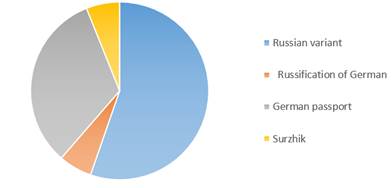
The illustration of the ratio of the responses of 197 tested (in absolute numerical terms) to the question "What is your name?" Here and below, the testing data are used in the Rosinka center (Lörrach-Rheinfelden, Germany, 2012-2017, Usikova, Morozova and Kudryavtseva as test pieces), OC "Russian Carinthia" (2016, Austria, Schöffmann as a testosterone) and individual tests of students of other centers of supplementary education with the Russian language of studing in Germany (2012-2017, Kudryavtseva as a dough). The tests were of a complex diagnostic nature and were not originally intended for carrying out similar statistical studies.
- Imagine your interlocutor says in all the languages of the world. Praise him! ... In some languages he speaks only the truth, but on others he sometimes thinks up something that is not real. Tell him what you think about the wrong information. You can also scold him.
The situations proposed to the child require, first of all, an emotional reaction (praise, censure) and the corresponding emotionally colored vocabulary, which can be presented only to the extent that it was previously perceived by the child-bilingual from the adult carriers of each ethno-linguistic culture. Native speakers of the Russian language in Germany for praise, as a rule (more than 80% of cases), choose Russian as more emotional, having greater variability of this vocabulary and grammar (diminutively affectionate suffixes); As a language of individual praise (as opposed to the averaging-general German "Gut gemacht, weiter so!"), etc.; Only if these children are praised at home and in the centers of additional education with the Russian language of instruction. If a child is deprived of such a positive experience, then the question of choosing a language of praise is irrelevant. They abuse both Russian and German, finding it difficult to explain the reason for choosing a particular language in deep interviews or explaining it as the preferred language of communication with peers (less often - the language of conflicts with parents, as some taboo topic). It is important that the age of the polyglot interlocutor was not exactly defined in any of the situations (the test subjects could decide for themselves whether they are older or their peers).
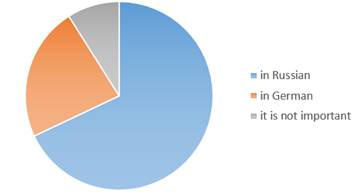
Illustrations of the ratio of responses 197 tested (in absolute numerical terms) to the question of the language of praise.
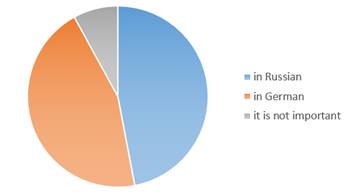
Illustrations of the ratio of responses 197 tested (in absolute numerical terms) to the question of the language of "abuse" – “The Russian language is the language ... (my, parents, mothers ...)”. Here we touch on one of the most controversial and most important (including the status of the Russian language outside the Russian Federation) problems: the definition of the Russian language by national-Russian and Russian-national bilinguals as a native, non-native or even foreign.
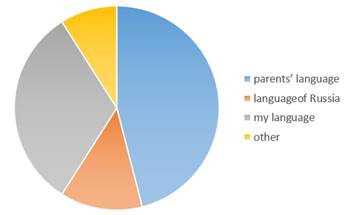
Illustrations of the ratio of responses 197 tested (in absolute numerical terms) to the question "The Russian language is ...” - If I'm in France, then I ... If I'm in Germany, then I ... If I'm in Russia, then I ... If I'm on an uninhabited island, then I ... (Russian / Russian, German, French, foreigner, man of the world ...). Self-awareness , dictated from the outside; determined by status indicators (for teenagers it's "cool" to be a foreigner in Russia, but in Germany it's more profitable to be a German), the attitude of adults and peers ("one's" among "strangers", "alien" among "our own", "Russian Germans" – Germans in the USSR, Russians in Germany). The question "Who am I by nationality?" Or "Why am I not like everyone else?" Bi-and polylinguals consciously formulate it at the age of 12-14 years, a teenage, complex and critical for physiological and psychological indicators. But the preparation for his production is from early childhood, from the first heard sounds of my mother's and father's speech. If the parents consistently observe the principle "1 person - 1 culture of behavior - 1 language", the child, when growing up, freely correlates verbal manifestations (language, speech) with non-verbal ones (ethno-cultural, behavioral indicators). And the language for him is the focus and reflection of culture: the Russian language is the culture of Russia; the German language is Germanic ethnoculture. Such
If one of the languages (ethnolinguistic culture) was violently suppressed (parents, surroundings) or implanted as mandatory (by the adult community, peers), then natural bilingualism remains potential or develops inadequately, which leads to an artificial displacement of the developmental paradigms of the child and to the feeling of his "otherness". Such children feel uncomfortable in any environment, and their answers in the test are reduced to the situation of "strange" among "their" and among "strangers" (in Germany - Russian, in Russia - German, in France – a foreigner, on an uninhabited island – no one…).
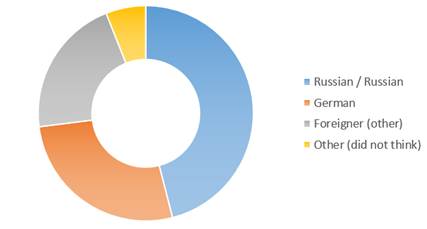
Illustration of the ratio of responses 197 tested for the assumption: "If I'm in Russia, then I ..." (all tested are taken as 100%). "Another" means here - "different from the inhabitants of a given country", "another".
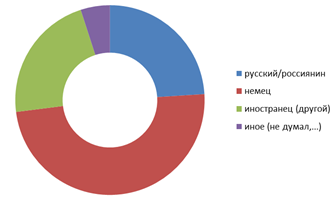
Illustration of the ratio of responses of the tested Russian Germans from the number of 197 tested – 47 according to their own definition based on the history of migration of the family on the assumption: "If I'm in Russia, then I ..." (tested Russian Germans are 100%)
The ratio of 197 tested answers to the assumption: "If I am in Germany, then I ..." (all tested are taken for 100%) radically differ: the absolute majority answers "I'm German," one fifth is "Russian", a very small percentage (5–6) notes themselves as a "foreigner" or "another".
A part of the questions of the complete diagnostic testing is aimed at finding out the volume of the test subject's vocabulary for key age themes. At the same time, the test subject is given the right to switch codes (switching to another language, if the vocabulary in Russian is not enough). For this purpose, there is a test-carrier of another, non-Russian language of the tested as native, on the verbal part of the test; And the tests exist both in Russian, taking into account the ethnolinguoculture of Russia, and in another language of the tested, taking into account the ethnolinguoculture of the country of his permanent residence. This allows us to determine the level of development of speech and the overall development of children and adolescents-bilinguals, taking into consideration the obligatory compensatory phenomenon and allowing them to choose the language (ethno-linguistic culture) actions and reactions.
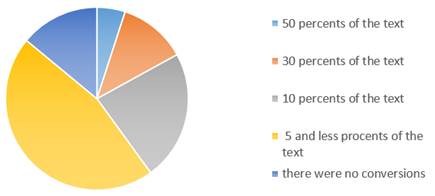
Illustration of the 197 responses tested by% of the unjustified content of the transition test tested in German (the relative absolute number of tested). For example, 50% of the test in German was performed by 6 tested, etc.
The choice of language is also conditioned by the desire of the speaker to be understood by all others or only by the immediate interlocutor (interlocutors) belonging to his social, ethnic, etc. group; often in the function of jargon used surzhik (mixing elements from several languages). Adolescents from socially successful families who seek to minimize contacts with the older generation (immigrants from the Russian Federation, the CIS, and the republics of the USSR) resort to English for this purpose, since surzhik in the family causes a sharply negative reaction from adults.
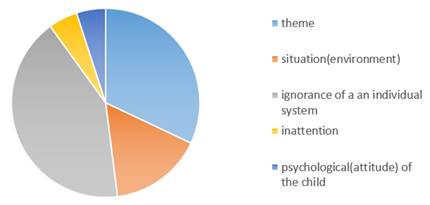
Illustration of reasons for transition to the German language in the testing process (the relative absolute number of tested). The data – both on the basis of the answers tested, and on the basis of observations of the test. The data are for oral testing (they are indicated by the marks in the repertory tables filled with testers during the testing process).
A survey of respondents aged 15-18 with Russian-German and German-Russian bilingualism was conducted in the format of remote e-communication (questionnaires and in-depth interviewing).
Findings
We have revealed that for children and adolescents bilinguals the concepts of "first" and "second", as well as "native" and "non-native" language differ from the use of these terms by Russian science. So, when asked about the "first" and "second" language, they, as a rule, reacted with a counter question about the principle of such numbering (the order of development, frequency of use, the number of communicative use situations, etc.). In this case, children and adolescents viewed as the optimal interpretation adopted in the world: 2L1 (two languages mastered as the first).
The attitude to language as "native" or "non-native" is often determined by psychological and social factors (the possibility, necessity and desire for self-presentation and self-identification in this language and through the system of this ethno linguistic culture). Instead of the "non-native", substitutes are often used: "the language of parents", "the language of the elders", "the language of the grandmother", etc. (I.e. "not my language"). In general, the choice of the language of communication for bilinguals is not spontaneous, depending on a set of factors (host country, language of the environment, for example, the language of the test, the specific situation of communication, etc.). In 14 years, German-Russian bi-and poly-lingua predominate (whereas up to six years the predominance of the Russian-German variant of bilingualism and multilingualism is possible). This is due to the first and second bilingualism crises (in fact, the crises of the "weak", not the country's language of communication) when the child get to kindergarten and school with the teaching exclusively in the country language (crises are relented when children and teenagers visit so-called "Russians" Schools "with the presence of an ethno linguistic culture and a positive attitude of the" similar "society to the national-Russian bilingualism). From the age of 7-8,begins a conscious definition of ethno-linguistic and cultural priorities (language is seen as an instrument for achieving personal and educational goals or as an obstacle to their access, "mother tongue" is associated with the language of the host country, citizenship and then a passport).
On the basis of our observations, we can say that: a) children of socially less successful parents (for example, recipients of social care in Germany, who are not able to find work, or who have received work that does not correspond to their level of education, while education is received in the USSR / RF and not recognized in Germany) are less open to integration than the children of socially successful parents (having a status profession, having a complete command of German and English, accepted by the German-speaking society). Accordingly, the social status of the older generation and its educational level affects the social status of children, and in the end - the choice of language, the ability to switch codes; B) the children of the "non-statutory" Russian language’s speakers today in the EU are less successfully integrated than their peers - the speakers of "status" English or Spanish. The presence in the social networks of cultural autonomous communities, groups, and websites also contributes to the desire for self-identification and self-presentation on the priority language for the community in the priority ethno-linguistic culture (including on the "Surzhik" as being closed to understanding outside of this ethno linguistic culture). Remaining Russian speakers (age levels B and C for complex diagnostic testing), our respondents are not carriers of the Russian national worldview (35 percent of those living in Russia and about 95 percent of the citizens in Germany); yet nonetheless open to a dialogue of cultures, positively-objectively referred to Russia and the CIS countries. The term "bilingual" in this respect is somewhat narrow; the term "bi-national / language as a nonnative / or international / native languages / person", reflecting not only the presence of a bi-or international worldview, but also the type of interinfluence of two ethno-linguistic cultures, up to their synthesis, but at a new level of perception and consciousness, is quite acceptable and even recommended for the description of the current generation of German-Russian and Russian-German bilinguals.
Conclusion
Our facts will be proposed and have already proposed for the coordination of scientific research in the field of historical and cultural interaction between the peoples of Germany and Russia, as well as the development of joint research programs to study the ethnolinguicultural phenomena of the "Russian Germans" and the national-Russian two- / multilingualism. For practicing teachers we have developed recommendations and a whole package of innovative materials (the complex tests, portfolios, playing technologies and didactic materials, etc. mentioned above, which enable us to work out, for example, the mechanism for switching verbal and non-verbal codes, to increase the level of intercultural communicative competence, all this - taking into account the linguocultural dominant). Realization is necessary of such moments in work as 1) involvement of parents and the centers of additional education in language of the country of an outcome to active participation in successive educational process and in development of a two-(multi) lingualism ("a triangle of mutual integration safety"); 2) need of tracking of a vector of formation and development bi-/polylingualism and measurement of competences of each of ethnocultures not in connection with “the Russian as a foreign languge” levels, and in connection with dynamics of the general age development of the child and taking into account features of his ethnolinguocultural and sociocultural environment; 3) education process long in life instead of training – in Russian in the country of accommodation of the child, considering specifics of a country context; 4) the consecutive attention (parental, methodical, research) to language of ancestors, historical roots of children-bilinguals promotes revival in them gene memory, tolerance, development of the identity of "the person of the world" demanded in the 21st century.Realization is necessary of such moments in work as 1) involvement of parents and the centers of additional education in language of the country of an outcome to active participation in successive educational process and in development of a two-(multi) lingualism ("a triangle of mutual integration safety"); 2) need of tracking of a vector of formation and development bi-/polylingualism and measurement of competences of each of ethnocultures not in connection with “the Russian as a foreign languge” levels, and in connection with dynamics of the general age development of the child and taking into account features of his ethnolinguocultural and sociocultural environment; 3) education process long in life instead of training – in Russian in the country of accommodation of the child, considering specifics of a country context; 4) the consecutive attention (parental, methodical, research) to language of ancestors, historical roots of children-bilinguals promotes revival in them gene memory, tolerance, development of the identity of "the person of the world" demanded in the 21st century.
Acknowledgements
The work is performed according to the Russian Government Program of Competitive Growth of Kazan Federal University.
References
- Complex diagnostic tests for the German-Russian bilinguals from 3 to 14 years: practical recommendations for conducting testing of bilingual children and teenagers (2016) / Comp.by E. L. Kudryavtseva; author - E. L. Kudryavtseva, A. A. Timofeeva, Yu. Yu. Danilova, D. A. Salimova, L. B. Bubekova. Schöneiche bei Berlin: Elena Plaksina Verlag,126.
- Koudrjavtseva E., Volkova T. (2014). BILIUM-Bilingualism Upgrade Module (Part II): A comprehensive approach to teaching bilingual children language (non-native and another/second native) in the early childhood educational systems (ECES) of the European Union: A framework for an advanced training programme for pre-school teachers and similar structural units in mainstream schools (pupils from the age of 1.5 years to 5 years) – Riga: RetorikaA, 96.
- Kudryavtseva E. L. (2015). The test for the level of communicative competence for children- bilinguals aged from 3 up to 14 years with Russian as one of the native languages: practical recommendations / E.L. Kudryavtseva, L. B. Bubekova, D. A. Salimova, A. A. Timofeeva. Interaction of languages and cultures: researches of graduates and potential participants of programs of Fulbright: materials of reports IV International scientific conference (Cherepovetsk, on April 15−16, 2015) / under the editorship of G. N. Chirsheva; соmp.by G. N. Chirsheva, V. P. Korovushkin. Cherepovetsk: Cherepovets state university, 53-57.
- Madden E. (2011). Russian-speaking children in Germany: some features of the speech. Onto linguistics — science of the 21st century: materials of international conference, the department of the children's speech of RSPU of A. I. Herzen devoted to the 20 anniversary, on May 4-6, 2011, St. Petersburg. – St. Petersburg: Zlatoust, 2011, 556 – 661
- Rafieyan, V., Bin Abdul Majid, N., and Eng, L.S., (2013). Relationship between Attitude and Target Compassion Development. English Language Teaching, 6.8, 125-132.
- Salimova, D.A. (2012) Bilingualism and translation: theory and experience of research: monograph / AA Timerkhanov, DA Salimova.- Moscow: Nauka: Flinta, 281.
- Salimova, D. (2014) Hope Johnson. Difficulties in the teaching of Russian as a foreign language: the perspectives of an ethnically Tatar specialist in Russian philology and an American student / Life Science Journal 2014; 11(5s), 11(5s): 219-223. http://www.lifesciencesite.com 42.
Copyright information

This work is licensed under a Creative Commons Attribution-NonCommercial-NoDerivatives 4.0 International License.
About this article
Publication Date
31 August 2017
Article Doi
eBook ISBN
978-1-80296-028-0
Publisher
Future Academy
Volume
29
Print ISBN (optional)
-
Edition Number
1st Edition
Pages
1-960
Subjects
Teacher, teacher training, teaching skills, teaching techniques
Cite this article as:
Salimova, D. A., & Koudrjavtseva, E. L. (2017). Language Preferences Of Children-Bilinguals In The Conditions Of Disperse Accommodation Of Ethnos. In R. Valeeva (Ed.), Teacher Education - IFTE 2017, vol 29. European Proceedings of Social and Behavioural Sciences (pp. 763-775). Future Academy. https://doi.org/10.15405/epsbs.2017.08.02.87

